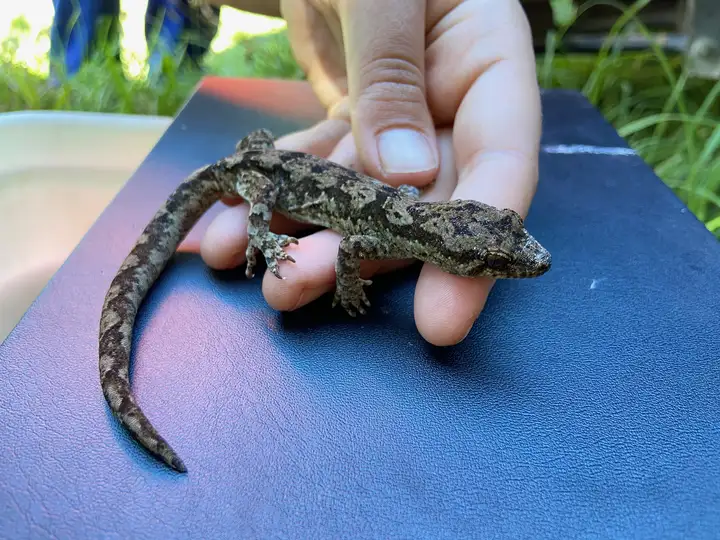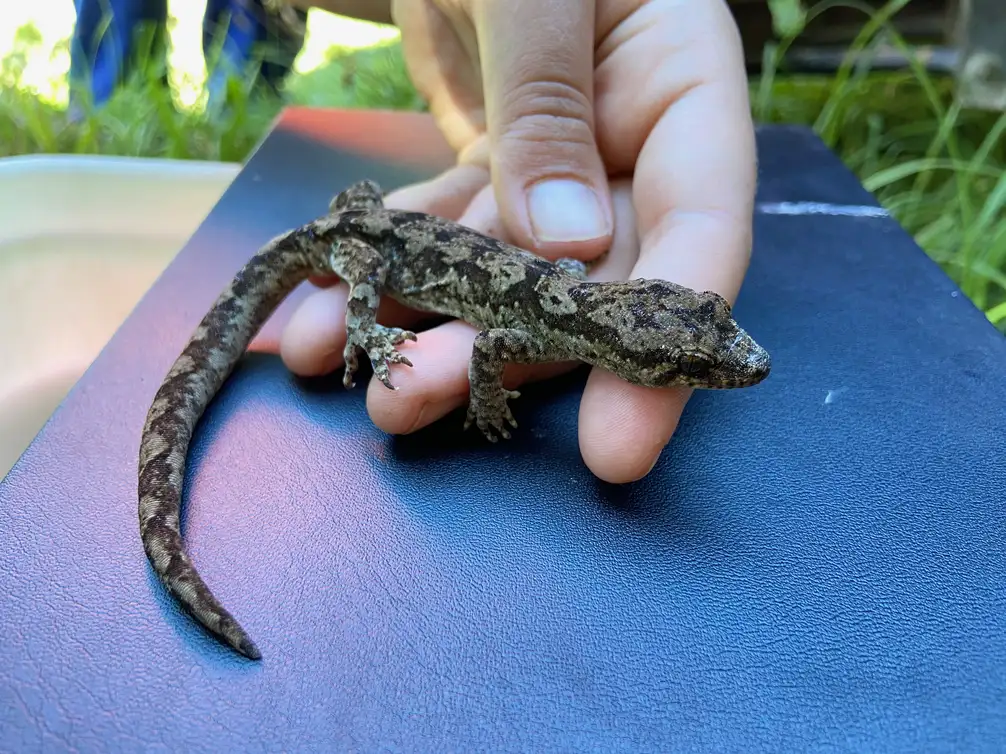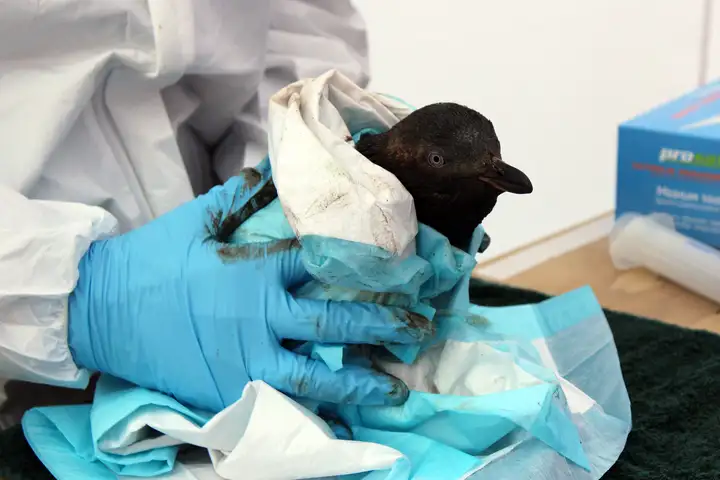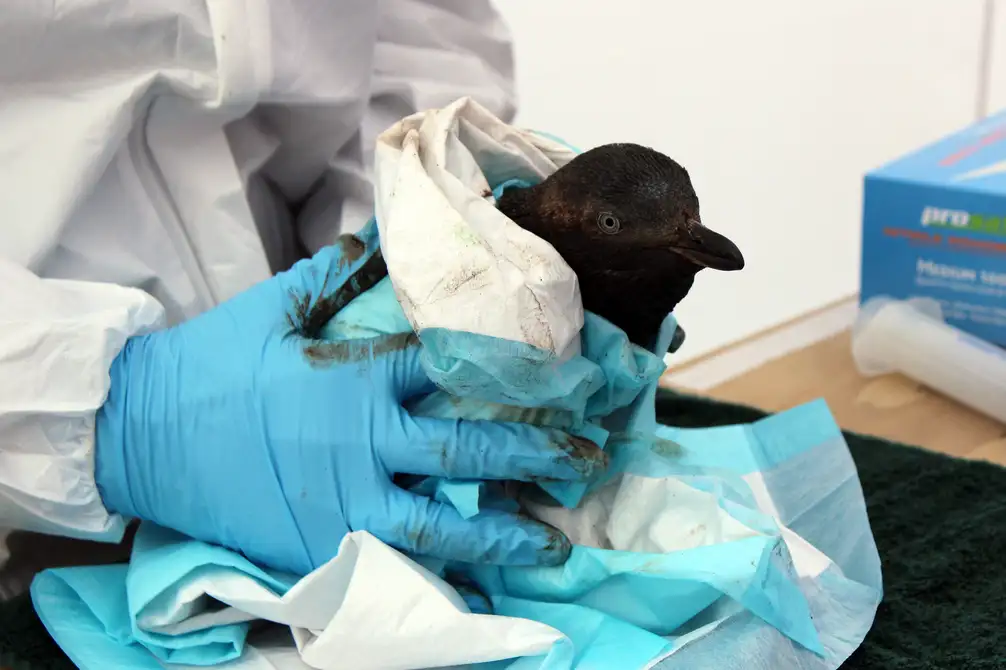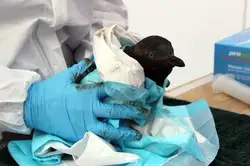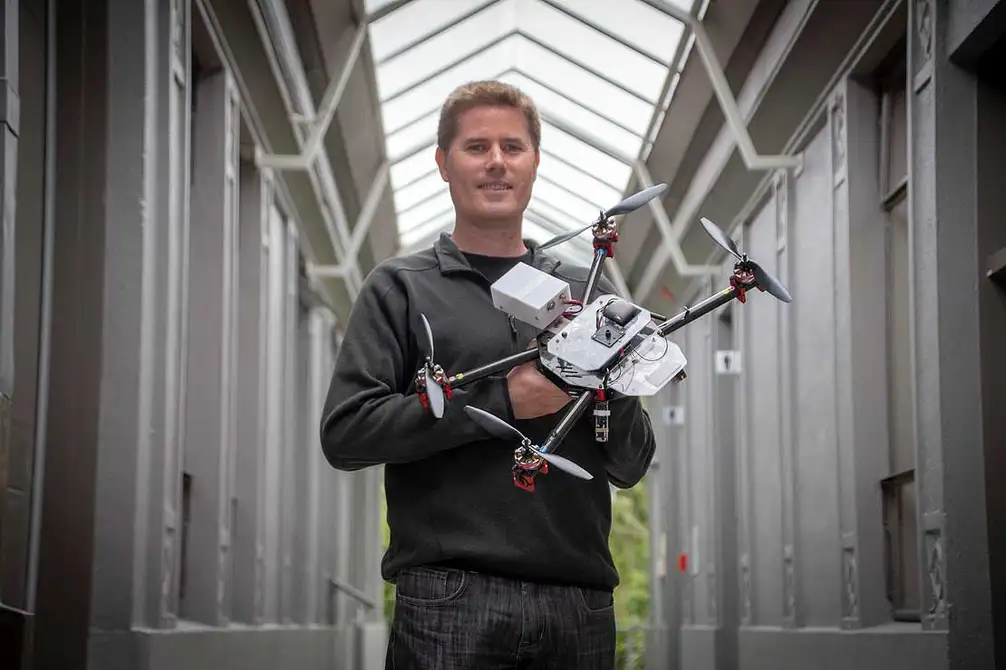On this page
Wildbase Research promotes collaborative investigation and management of wildlife. We support the welfare and conservation of New Zealand native fauna.
Collaborations
In New Zealand we work with:
- Maritime New Zealand
- Massey Ecology Group
- Department of Conservation
- Ministry of Primary Industries
- Victoria University of Wellington
International collaborations are with:
Areas of expertise
Oiled wildlife response
Research relevant to oiled wildlife response includes:
- areas of wildlife health and rehabilitation
- wildlife ecology
- foraging behaviour and management
- economics analysis of oil spills
- compassion fatigue of wildlife emergency responders
- aspects of oiled wildlife preparedness and response management.
Current research
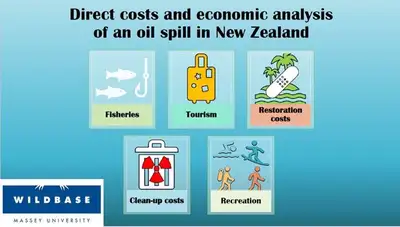
Wildbase Research staff research a range of aspects of oiled wildlife response. This includes wildlife biology and applied research to improve oiled wildlife response procedures and techniques. Some current projects are listed here.
- Impacts and Rehabilitation Success of Wildlife from MV Rena, New Zealand.
- Direct Costs and Economic Analysis of an Oil Spill in New Zealand.
- Compassion Fatigue.
- Sources and Reporting of Oil Spills and Impacts on Wildlife.
- Species Prioritization Index for Oiled Wildlife Response Planning
- Determining distribution, abundance and foraging ecology of seabirds and marine mammals around New Zealand
For more information contact us at: wildbase@massey.ac.nz
Published research
Publications linked to Wildbase Oiled Wildlife Response
Egan, A. L., Chilvers, B. L., & Cassells, S. (2021). Does size matter? The direct economic costs associated with the MV Rena oil spill. Marine Pollution Bulletin, 173, 112978
White, B. P., Yeung, P., Chilvers, B. L., & O’Donoghue, K. (2021). Reducing the “cost of caring” in animal-care professionals: Social work contribution in a pilot education program to address burnout and compassion fatigue. Journal of Human Behavior in the Social Environment, 31(7), 828–847 1
Chilvers, B. L. (2021). Oiled wildlife response planning for subantarctic islands: A review for New Zealand subantarctics. Marine Pollution Bulletin, 171, 112722
Chilvers B. L. (2021). Pup numbers, estimated population size, and monitoring of New Zealand fur seals in Doubtful/Pateā, Dusky and Breaksea Sounds, and Chalky Inlet, Fiordland, New Zealand 2021. New Zealand Journal of Marine and Freshwater Research. 1–13
Yeung, P., White, B., Ziccardi, M., & Chilvers, B. L. (2021). What Helps Oiled Wildlife Responders Care for Animals While Minimizing Stress and Compassion Fatigue Animals. 11(7), 1952. DOI: 10.3390/ani11071952
Chilvers, B. L., & Dobbins, M. L. (2021). Behavioural plasticity and population connectivity: Contributors to the establishment of new pinniped breeding colonies. Aquatic Conservation: Marine and Freshwater Ecosystems. 31(9) DOI:10.1002/aqc.3603
Chilvers B. L. (2021). Identifying female foraging ecotype and fisheries impacts through pup whisker stable isotopes. Aquatic Conservation: Marine and Freshwater Ecosystems. 31(8). DOI:10.1002/aqc.3589
Chilvers B. L. (2021). Living on the Edge, the New Zealand Sea Lion. Ethology and Behavioral Ecology of Otariids and the Odobenid. 539-555
Chilvers B. L. (2021). Isotope values from milk and blood serum in New Zealand sea lions: are pups feeding on milk a trophic level higher than their mothers? Marine Biology, 168(1), 1–7
Chilvers, B. L., Morgan, K. J., & White B. J. (2021). Sources and reporting of oil spills and impacts on wildlife 1970–2018. Environmental Science and Pollution Research 28(1), 754–762
Chilvers, B. L., Amey, J. M., & Costa, D. P. (2020). Extreme diving of females at the largest colony of New Zealand sea lions, Phocarctos hookeri. Polar Biology, 43(12), 2031–2042
Muller, C. G., Chilvers, B. L., French, R. K., & Battley, P. F. (2020). Diving plasticity in the ancestral range of the yellow-eyed penguin Megadyptes antipodes, an endangered marine predator. Marine Ecology Progress Series 648, 191–205
Muller, C. G., Chilvers, B. L., French, R. K., Hiscock, J. A., & Battley, P. F. ( 2020). Population estimate for Yellow-eyed Penguins (Megadyptes antipodes) in the subantarctic Auckland Islands, New Zealand. Notornis, 67, 299–319
Chilvers, B. L., & Battley, P. F. (2019). Species prioritization index for oiled wildlife response planning in New Zealand. Marine Pollution Bulletin, 149, 110529
Gartrell, B. D., Battley, P. F., Clumpner, C., Dwyer, W., Hunter, S., Jensen, M., McConnell, H. M., Michael, S., Morgan, K. J., Nijman, P., Ward, J. M., White, B. J., Ziccardi, & M. H. (2019). Captive husbandry and veterinary care of seabirds during the MV Rena oil spill response. Wildlife Research, 46, 610–621
Sievwright, K. A., Battley, P. F., McConnell, H. M., Armstrong, D. P., & Morgan, M. J. (2019). Survival rates of oil-rehabilitated and non-rehabilitated little penguins after the C/V Rena oil spill, New Zealand. Marine Pollution Bulletin, 146, 317–325
Sievwright, K. A., Battley, P. F., McConnell, H. M., Chilvers, B. L., & Morgan, M. J. (2019). Post-release breeding success of oil-rehabilitated and non-rehabilitated little blue penguins, Eudyptula minor, following the M/V Rena oil spill, New Zealand. Marine Pollution Bulletin, 149, 110553
Hunter, S. A., Tennyson, A. J. D., Bartle, J. A. S., Miskelly, C. M., Waugh, S. M., McConnell, H. M., Morgan, K. J., Finlayson, S. T., Baylis, S. M., Chilvers, B. L., & Gartrell, B. D. (2019). Assessing avian mortality during oil spills: a case study of the New Zealand MV ‘Rena’ oil spill, 2011. Endangered Species Research, 39. 303–314
Finlayson, G. R., Chilvers, B. L., Pearson, H., White, B. J., Finlayson, S. T., Sievwright, K., van Zyla, N., Morgan, K. J., & Clumpner, C. (2017). Efficacy of seawater for washing oiled birds during an oil spill response. Marine Pollution Bulletin, 126,137–140
Chilvers, B. L., Finlayson, G., Candy, E. J., Sriram, A., Morgan, K. J., & Cockrem, J. F. (2016). Corticosterone stress hormone responses in oil rehabilitated and non-rehabilitated little penguins. Marine Pollution Bulletin, 113, 312–315
Chilvers, B. L., Finlayson, G., Ashwell, D., Low, S. I., Morgan, K. J., & Pearson, H. E. (2016). Is the way an oil spill response is reported in the media important for the final perception of the clean-up? Marine Pollution Bulletin, 104(1) DOI:10.1016/j.marpolbul.2016.01.013
Chilvers, B. L., Morgan, K. J., Finlayson, G., & Sievwright, K. (2015). Diving behaviour of wildlife impacted by an oil spill: A clean-up and rehabilitation success? Marine Pollution Bulletin, 100, 128–133.
McConnell, H. M., Morgan, K. J., Sine, A., Leung, Y. B., Ward, J. M., Chilvers, B. L., & Gartrell, B. (2015). Using sea water for cleaning oil from seabird feathers. Methods in Ecology and Evolution, DOI: doi.org/10.1111/2041-210X.12413
McConnell, H., Gartrell, B. D., Chilvers, B. L., Finlayson, S. T., Bridgen, P. C. E., & Morgan, K. J. (2015). Baseline hydrocarbon levels in New Zealand coastal and marine avifauna. Marine Pollution Bulletin, 94, DOI: 10.1016/j.marpolbul.2015.02.001.
Leung, Y-M. B., Morgan, K. J., White, B. J., Ward, J. M., & Chilvers, B. L. (2015). Washing oiled marine birds in New Zealand: Do we have a detergent that can be used? New Zealand Journal of Marine and Freshwater Research, DOI: 10.1080/00288330.2014.993661
Yeung, P., White, B., & Chilvers, B. L. (2017). Exploring Wellness of Wildlife Carers in New Zealand: A Descriptive Study. Anthrozoös, 30, 49–563, DOI: 10.1080/08927936.2017.1370213
White, B., Yeung, P., & Chilvers, B. L. (2021). Reducing the “cost of caring” in animal-care professionals: Social work contribution in a pilot education program to address burnout and compassion fatigue. Journal of Human Behaviour in the Social Environment, 828–847, DOI: doi.org/10.1080/10911359.2020.1822249
Find out more
Learn about the Wildbase Oiled Wildlife Response team and what they do
For more information, contact Louise Chilvers
Ecology
Being able to understand and care for wildlife means knowing how they behave and adapt in their natural habitat. Wildlife ecology research is integral to wildlife health, behaviour, physiology and nutrition.
For more information about wildlife ecology, contact Louise Chilvers
Toxicology of wildlife
Wildbase scientists are heavily invested in research into the health of wildlife as individuals and as populations. Areas of research include identifying causes of wildlife mortality, wildlife disease ecology and toxicology.
For more information on toxicology of wildlife research at Wildbase, contact:
Wildlife anatomy and physiology
Understanding animals’ physiological responses to the environment and to human management is a key area of research for Wildbase.
This area includes research into behaviour, responses to capture and handling, and the physiology of growth, stress and reproduction.
The unique avifauna of Aotearoa New Zealand has many anatomical oddities yet to be fully described. Wildbase is focused on expanding knowledge of avian anatomy, particularly where it is clinically relevant veterinary care of these species.
For more information about wildlife anatomy and physiology research at Wildbase, contact:
Wildlife nutrition
Wildbase scientists are involved in research on the nutrition of both free-living and captive wildlife. This includes research into optimal diets for breeding programmes, translocations and the critical care of wildlife species.
For more information about wildlife nutrition research at Wildbase, contact:
Compassion fatigue
Wildbase researchers have recognised the need for cross-disciplinary studies into the human impacts of wildlife emergencies. Research is ongoing into tools and strategies that can improve the professional quality of life of humans working in emergency response and other animal care situations.
For more information about compassion fatigue research at Wildbase, contact:
Individual avian health
Advancing avian veterinary care is a priority for Wildbase, particularly where it can impact conservation through the advanced care of critically endangered species.
Every individual can make an important contribution to the survival of these species. Research in this area includes investigation of pain relief protocols in kererū, kāhu and kiwi.
For more information about avian health research at Wildbase, contact:
Current research projects
Pathogen prevalence and diversity in native and invasive New Zealand lizards
Student: Shelly Butcher
Supervisors: Professor Brett Gartrell (Wildbase, Massey University), Doctor Marleen Baling (Unitech) and Kate McInnes (Department of Conservation)
The project is investigating the pathogen prevalence and diversity of native lizards and the only introduced reptile in New Zealand, the rainbow skink. The aim is to determine if the introduced rainbow skink poses a disease threat to native geckos and skinks.
Direct economic losses of oil spills in populated and remote locations within New Zealand
Student: Alexandra L. Egan
Supervisors: Louise Chilvers and Sue Cassells
Alexandra's research aims to estimate the direct losses associated with oil spills within New Zealand, specifically the MV Rena oil spill off the coast of Tauranga in 2011, and a hypothetical oil spill in Milford Sound, Fiordland National Park.
The impacts to market values, such as commercial fisheries, tourism, clean-up and restoration costs will be considered.
The losses to recreation (swimming, walking, boat tours and so on), a non-market value, were investigated. This was done by surveying the users of these two sites to understand their past visitation behaviour, and how their future behaviour would change in the event of different oil spill scenarios.
These results will allow us to have a better understanding the costs associated with oil spills in New Zealand, allowing us to make more informed policy decisions so that we are better prepared for any future spills.
Avipoxvirus in tūturuatu (New Zealand shore plover)
Research lead: Professor Brett Gartrell
Conservation efforts to save one of the world’s most endangered shorebirds, the tūturuatu (New Zealand Shore plover), which is on the endangered International Union for Conservation of Nature (IUCN) red list, are severely hampered by their susceptibility to avipoxvirus.
Ongoing research aims to better understand the effects of the virus and develop potential management strategies to improve captive breeding success and support the remaining breeding population, which is estimated to be down to 70 pairs.
Kiwi coccidiosis: diagnostics and therapeutics
Student: Emma Scheltema
Supervisors: Associate Professor Kerri Morgan, Associate Professor Laryssa Howe and Doctor Preet Singh
Coccidiosis in kiwi is currently the main limiting disease in captive and creche-reared kiwi in the Operation Nest Egg programme, causing significant morbidity and mortality in young birds.
Previous work has shown coccidia occur in all five species of kiwi. Multiple coccidia species having been identified in the gastrointestinal tract and renal and hepatobiliary organs.
Current diagnosis is via coproscopic examination, and if detected, coccidiosis is managed through a combination of husbandry and medication (coccidiocides). This diagnostic approach gives little information on the prevalence of different coccidia species in kiwi, nor each species relative pathogenicity. In addition, recent evidence suggests that the efficacy of the primary drug used to treat coccidia (toltrazuril) is declining, leaving few safe alternative options for treatment of this disease in kiwi.
This project aims to further develop molecular tools to improve diagnosis of different coccidia species, and to use these tools to investigate the efficacy of alternative therapeutics for the treatment and control of coccidiosis in kiwi. If coccidiosis cannot be safely and effectively treated in kiwi, both individual bird health and welfare, as well as the conservation outcomes of captive-rearing programmes will be impacted. Thus, there is an urgent need to identify suitable effective alternatives to toltrazuril.
Mental health of trained oiled wildlife responders: Understanding stress management and coping strategies in animal care professionals during the 2011 MV Rena oil spill response
Student: Bridey White
Supervisors: Doctor Chrissy Severinson and Associate Professor Polly Yeung
Bridey is interested in investigating through qualitative methods, how oil spill response involving wildlife, during the 2011 Marine Vessel Rena oil spill, has affected the mental health of trained responders and what coping mechanisms were used to deal with stress.
Bridey hopes to identify strategies and support systems that could be integrated into workplace policy and future planning for oil spill response work.
Population ecology and foraging behaviour of yellow-eyed penguins on the subantarctic Auckland Islands
Student: Chris Muller
Supervisors: Louise Chilvers, Phil Battley (Ecology)
Yellow-eyed penguins (hoiho) are one of the world’s rarest penguins. They are found only in New Zealand waters, around the lower South Island and subantarctic islands. They are endangered, and declining, with populations on the mainland predicted to go extinct in a few decades.
Despite this, little is known about the subantarctic population because the area is a difficult place to reach and carry out researching.
Research into the the Auckland Islands yellow-eyed penguin population focuses on:
- population ecology
- foraging and diving behaviour
- breeding success
- diet.
We are currently developing the use of unmanned aerial vehicles (UAVs or drones) for conservation, deploying GPS loggers, depth loggers and VHF transmitters on diving penguins and using Stable Isotope Analysis to evaluate diet.
